
RADIACODE
The world's first pocket-size geiger counter and gamma spectrometer for all natural science enthusiasts and hobbyists in nuclear physics that uses a highly sensitive scintillation detector for analyzing environmental radiation levels in real time. Radiacode 102 detects and analyse isotopes using the radiation spectrum. The tool for all natural science enthusiasts passionate experimentation, research, and safety.
Διαθέσιμο, συνήθως σε 5-14 μέρες

Detector of nuclear radiation and spectrometer Radiacode 102
The world's first pocket-size geiger counter and gamma spectrometer for all natural science enthusiasts and hobbyists in nuclear physics that uses a highly sensitive scintillation detector for analyzing environmental radiation levels in real time. Radiacode 102 detects and analyse isotopes using the radiation spectrum. The tool for all natural science enthusiasts passionate experimentation, research, and safety.
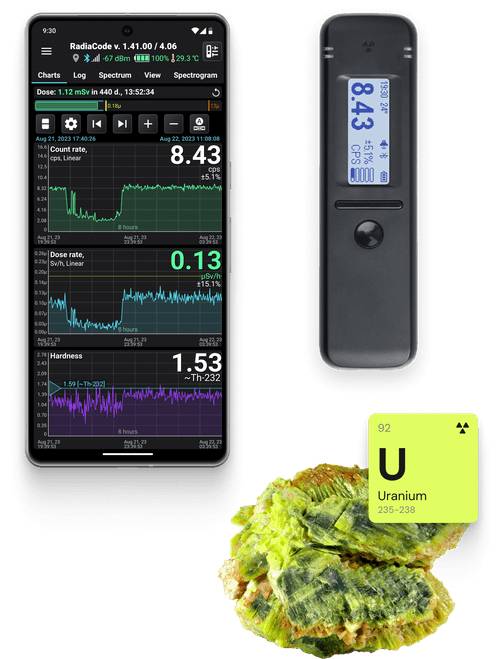 The Next-Generation Geiger Counter
The Next-Generation Geiger Counter
Radiacode is a next-generation "Geiger counter" that radically changes the concept of nuclear radiation detection.
The counting rate of Radiacode under natural background is 300-500 CPM (Counts per Minute), which is, on average, 15-20 times higher than conventional Geiger counters. The high efficiency of the scintillation sensor allows it to acquire more data and respond to changes in real-time.
What advantages does this provide? Imagine finding yourself in an unfamiliar area and wanting to explore the territory for radiation. With a regular Geiger counter, you would need to move at a pace of 2-3 steps per minute. However, with Radiacode, you can walk at a normal speed and even record the radiation levels at each point. You could even record the radioactive path with GPS coordinates on Google Maps.
Each device undergoes temperature calibration ranging from +50 to -20 degrees Celsius, ensuring stable readings regardless of the temperature. Radiacode will provide accurate readings in any weather conditions.
 Radiacode features Energy Compensation of the dose rate, allowing for equally precise measurement of both high-energy gamma radiation and low-energy X-rays.
Radiacode features Energy Compensation of the dose rate, allowing for equally precise measurement of both high-energy gamma radiation and low-energy X-rays.
Measurement is conducted simultaneously in two channels: dose rate in microsieverts and impulses in CPS. In other words, one channel displays radiation intensity, while the other reflects the impact on living organisms. Different isotopes and radiation sources affect organisms differently, and Radiacode can recognize their energy and display accurate data regarding dose exposure.
Importantly, for both CPS and μSv measurements, there is an alarm system that you can configure according to your preferences.
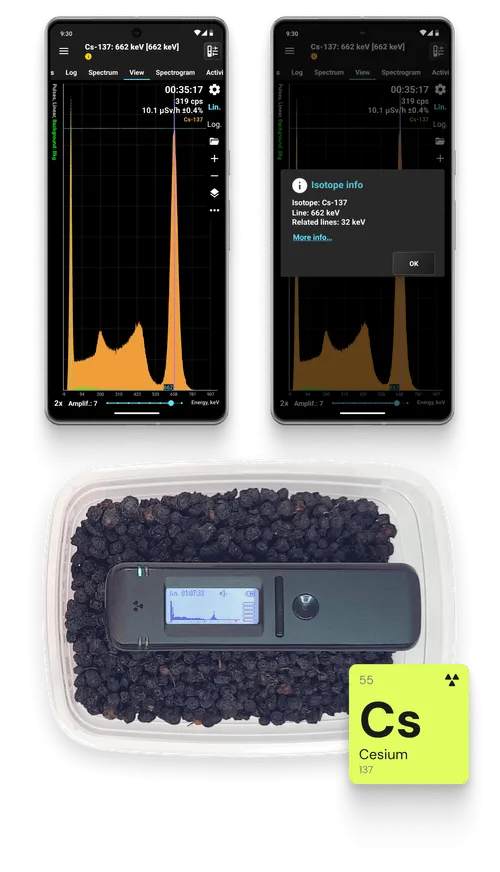 Isotope Identification
Isotope Identification
Gamma spectrometry is a standout feature of Radiacode, making it a breakthrough in the realm of radiation detectors. Previously accessible only with costly laboratory equipment, this capability now fits into a pocket-sized device weighing just 67 grams.
Now, you can identify radiation sources, whether it's Radium-226, Cesium-137, Thorium-232, Am-241, or a number of other isotopes.
This is fascinating from a scientific perspective, as it immerses you in the mysterious world of nuclear physics and provides insight into the invisible matter around us. Study radiation sources, formulate hypotheses, engage in discussions within our communities of like-minded individuals, and make discoveries. It also has a vital practical applications.
From a safety standpoint, this is essential. If you detect isotopes like Radium-226, Cesium-137, or Americium in an urban environment, it's a reason to alert emergency services.
 Furthermore, it holds significant importance if you happen to be in regions affected by the aftermath of the Chernobyl rains in 1986, as well as areas affected by nuclear tests and accidents. This impact extends to specific regions across Eastern, Western, and Northern Europe, the United States, Japan, Ukraine, Belarus, and Russia. The consumption of certain locally grown products from these lands could continue to pose health risks for the next 30 to 100 years, due to the presence of Cs-137 in these organic materials.
Furthermore, it holds significant importance if you happen to be in regions affected by the aftermath of the Chernobyl rains in 1986, as well as areas affected by nuclear tests and accidents. This impact extends to specific regions across Eastern, Western, and Northern Europe, the United States, Japan, Ukraine, Belarus, and Russia. The consumption of certain locally grown products from these lands could continue to pose health risks for the next 30 to 100 years, due to the presence of Cs-137 in these organic materials.
Every device has individual temperature calibration, ensuring consistent spectral recording even under significant temperature variations. The accuracy of the spectrum will be maintained regardless of temperature fluctuations. The spectrum resolution for Cs-137 is 8.4% ±0.3% (Radiacode 103) Full Width at Half Maximum (FWHM), considered the industry standards for scintillation spectroscopic equipment. For optimal visualization, you can view the spectrum chart on a Bluetooth-connected smartphone or PC.
You may have thought that spectrometry is complex and requires special skills. But it's actually quite simple. Just bring the device close to the object of study and restart the spectrum collection. Depending on the type of isotope and the source's strength, it may take anywhere from a few seconds to several hours.
Spectrum isotope library
Access to ever-growing Spectrum Isotope Library, enriched by our community’s contributions. Explore the isotopes already discovered and contribute to advancing scientific research.

 Radiation Mapping
Radiation Mapping
Radiacode's captivating feature is its ability to record radiation measurements on Google Maps or OpenStreetMap (OSM) when synchronized with a smartphone via Bluetooth.
The device automatically captures radiation levels at user-defined intervals, creating a track composed of colored points on the map. The color of the track represents the radiation level at the corresponding location: shades of red signify higher levels, yellow indicates moderate levels, and blue and green show lower levels. This color-coding is as straightforward as a traffic light system.
Additionally, you have the option to customize your own color palettes. You can also export your maps to share with other Radiacode users or import their maps directly into your application.
Radiacode is your “sixth sense” in the world of radiation. You will discover places with elevated or reduced radiation levels, which may indicate interesting and unusual phenomena or objects.
Food Activity Monitoring
Radiacode has a specialized mode for measuring the presence of Cesium-137 in food products.
Cesium-137 is the most common nuclear isotope worldwide, settling across large areas of our planet after numerous nuclear tests in the USA and USSR, as well as several nuclear accidents, including Chernobyl. Winds and rains have carried Cesium-137 over vast distances, and traces of it can even be found in Africa and Antarctica.
The issue with Cesium-137 is that it's a synthetic isotope, never found in nature prior to its creation by humans. Living organisms mistake it for elements used in building organic tissues. Once it enters the human or animal body, it accumulates in the muscles, heart, and liver, where it can potentially remain throughout one's lifetime.
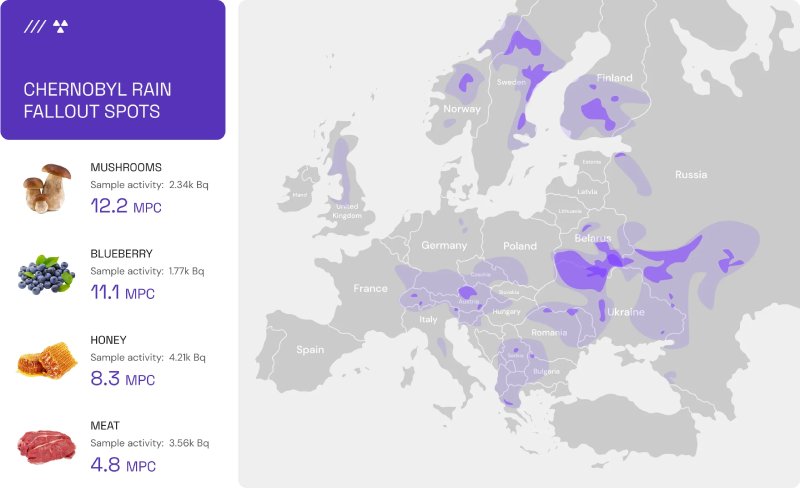
Unlike trace elements such as K, Ca, Zn, Fe, etc., which are beneficial to the body in small doses, Cesium-137 is harmful in any quantity.
Radiacode enables the measurement of the absolute and/or specific activity in various food products (expressed in Bq/kg) or provides results relative to maximum permissible concentrations (MPC).
With Radiacode, Cesium-137 can be detected in products such as berries, mushrooms, dairy products, domestic meat and game, honey, fish, and more. Ordinary dosimeters can only detect radiation in heavily contaminated products and cannot identify the presence of Cesium-137 as such.
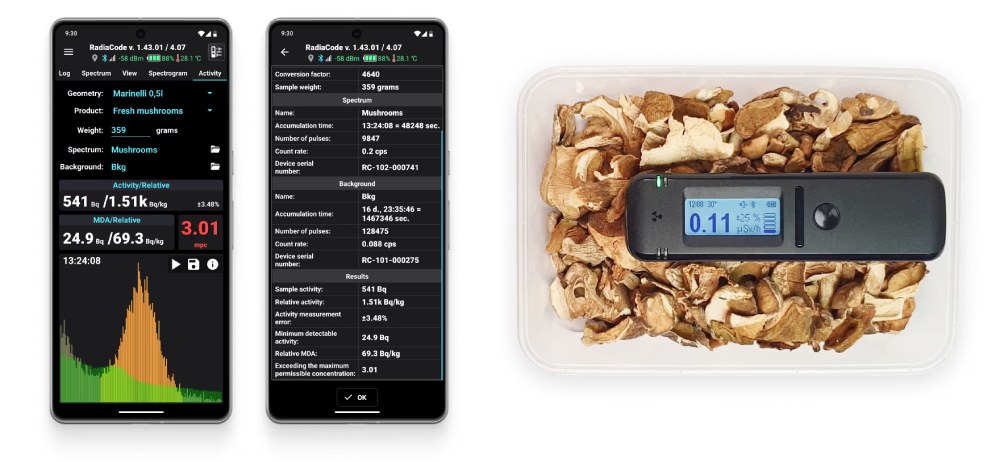
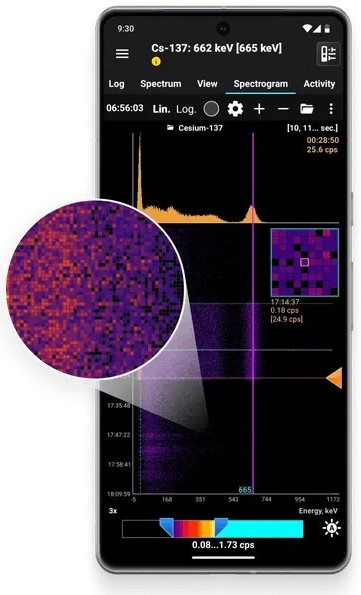 Spectrogram Functionality
Spectrogram Functionality
A spectrogram is a collection of gamma spectra recorded at specified time intervals, presented as a colored array capable of storing thousands of spectra. Don't worry, the recording is done automatically, continuously, and essentially without user involvement but can be extremely useful in various situations.
This mode assists in identifying the source of radiation if your alarm system suddenly starts and goes off, but you cannot immediately determine its cause.
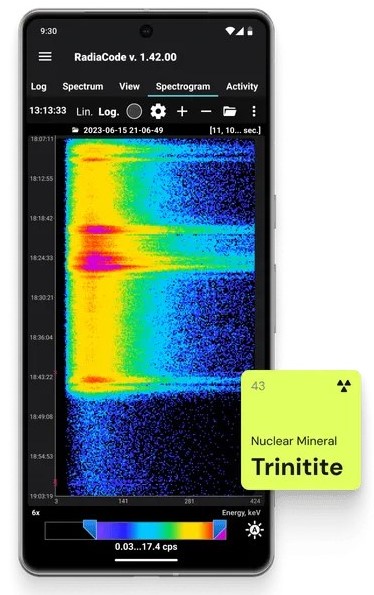 As an example, it is quite possible to identify the radiation source as individuals who have undergone radioisotope therapy or contrast imaging pass by. Typically, these individuals trigger the alarm briefly as they pass, after which the background radiation levels quickly return to normal, leaving the user seriously concerned about the reasons for the device's activation.
As an example, it is quite possible to identify the radiation source as individuals who have undergone radioisotope therapy or contrast imaging pass by. Typically, these individuals trigger the alarm briefly as they pass, after which the background radiation levels quickly return to normal, leaving the user seriously concerned about the reasons for the device's activation.
In this case, the spectrogram operating in the background mode is likely to provide an explanation, having had time to record data about the event. By examining the recorded spectrogram at a convenient time, the user may discover that the source of the short-lived radiation spike was, for example, Technetium-99m.
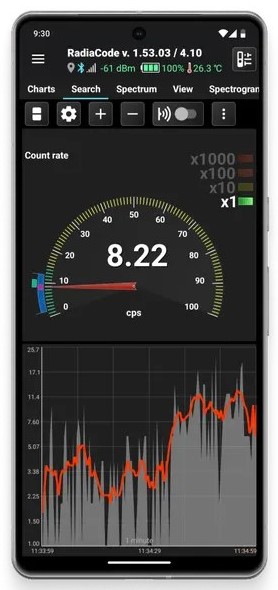 Advanced Search Mode
Advanced Search Mode
This mode is specifically designed to help you detect radiation with maximum sensitivity, ensuring swift and efficient movement during critical operations. With real-time updates, readings refresh twice per second, allowing you to cover larger areas in less time without compromising accuracy. Enhanced audio feedback, available through your smartphone or headphones, keeps you informed in noisy or sensitive environments without drawing unwanted attention. The analog indicator provides peripheral awareness, enabling you to monitor radiation levels without constantly checking the screen, making it easier to react in dynamic situations. For those tracking radiation levels over time, the visual graph helps identify rising trends and allows for timely adjustments. Additionally, the modified algorithm minimizes response delays, offering faster feedback for split-second decision-making.
Built on decades of experience with analog detection technologies and utilizing highly sensitive scintillator technology, this mode ensures the most responsive tool for radiation detection, helping you complete your mission quickly, safely, and accurately.
Radiacode Sensor
The Radiacode scintillation crystal, possessing optimal shape and size, in conjunction with the solid-state photomultiplier, provides high sensitivity across a broad range of ionizing radiation energies.
Cubic-shaped crystal, securу consistent sensitivity irrespective of the device's orientation towards the radiation source.
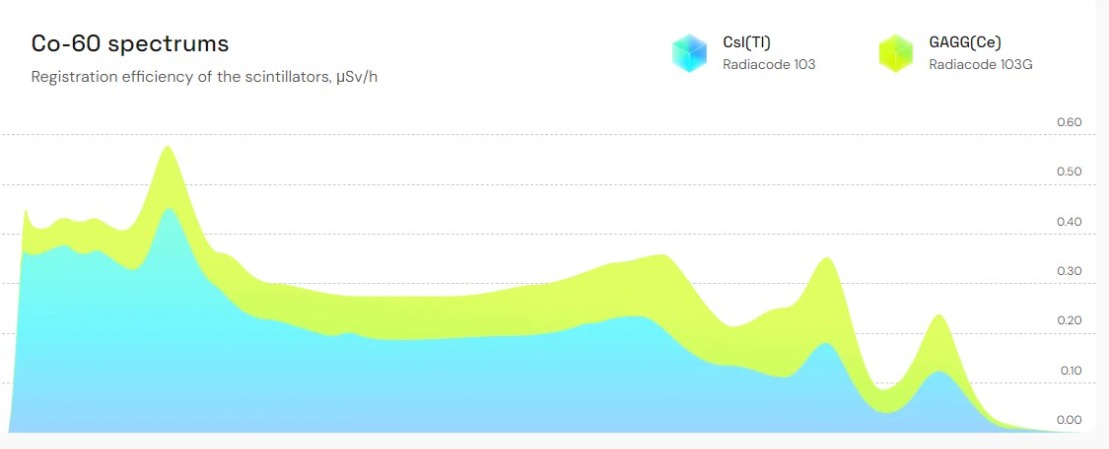
Modes of Operations
The Radiacode device operates in a continuous manner, gathering, storing, and analyzing data over time. As a result, at any given moment, the device's display can showcase one of several options for assessing radiation levels.
When the Radiacode device is connected to a smartphone via Bluetooth, the RadiaCode app further expands the display options for assessing radiation levels.
Detector
Csl (TI)
Crystal 10x10x10 mm
+ solid-state photomultiplier 3x3 mm
Energy resolution
9.4% ±0.4% (FWHM) for Cs-137
Radiation sensitivity
Cs-137 - 1 μSv/h = 30 cps
Co-60 - 1 μSv/h = 10 cps
Indicating range of radiation intensity
0.01 - 1000 μSv/h (Cs-137)
Indicating range of integrated dose
0.001 - 10 Sv
Energy range
0.02 - 3.0 MeV
Energy compensation
Yes
Installed battery
Li-pol 3.7 V, 1000 mAh up to 200 hours on single charge
Display
Monochrome graphic LCD, 128x48 pixels, 34x13 mm, FSTN, Transflective, Positive
Operating temperature range
-10 … +45°C
Dimensions and weight
124x35x20 mm
65 g
What's in the box: